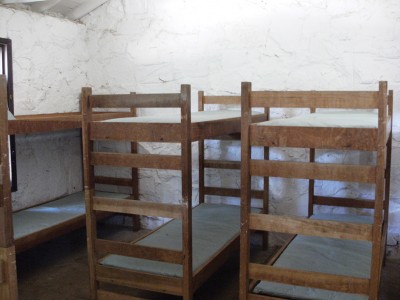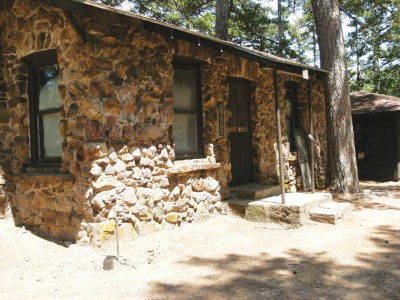My first sight on entering Camp Tom Hale—three hours southeast of Tulsa, off County Road 249—was a white pickup truck with a driver who looked to be about 13 years old. He nodded in my direction, a fitting welcome to this city of boys. I’d come to the camp with an Australian journalist named Gina Perry. She contacted me after discovering my story in This Land about the Robbers Cave Experiment (February 15, 2012), conducted at Camp Tom Hale in 1954. Gina was coming to the United States to gather material for a radio documentary about the experiment, and she asked if I would drive her to the campgrounds. Even without the surreal coincidence of our near-identical names, I would have said yes.
Gina’s background is in psychology, and her previous documentary examined the infamous Stanley Milgram shock experiments conducted at Yale in the 1960s. In Milgram’s experiments, researchers instructed participants to deliver increasingly large shocks to another person, sometimes past the point of apparent death. They did not know that the other participant was an actor and the shock machine was not real. Milgram wanted to test the idea that normal, otherwise moral people would commit atrocities if ordered to by an authority figure.
The Robbers Cave Experiment, conducted by University of Oklahoma psychologist Muzafer Sherif, was a natural follow-up for Gina. It had similar themes: a glimpse into the darker side of human nature and ethically questionable experiments that subjected people to great emotional trauma.
In Sherif’s study, two groups of adolescent boys were brought to what they thought was an ordinary summer camp. The researchers, posing as camp staff, created situations that put the two sets of boys in conflict. Before long, they developed strong group identities, calling themselves the Rattlers and the Eagles, and fell into a bitter rivalry that led to ransacked cabins, burned flags, and fistfights.
Gina spoke of details she had discovered that put the story in a new light. We discussed O.J.Harvey, Sherif’s research assistant who passed away last October. He was 26 years old at the time of the experiment. Over the three-week camp, Harvey and other young staff got about three hours of sleep per day, working late into the night to record their notes after the boys went to bed. Harvey was responsible for recruiting all of the children to the camp and managing half the boys. Harvey’s other responsibility was managing Sherif, who could have an explosive temper and who struggled with undiagnosed and untreated manic depression.
The modern Boy Scout camp that Gina and I had come to visit presented a much happier exterior. We were welcomed by camp director Greg Hall, a round-faced man with a boyish grin always playing at the edges of his lips. Hall is a passionate salesman of the Boy Scouts of America. As we toured the camp, he asked everyone we met to recite the 12 precepts of the Boy Scout Law: A scout is “trustworthy, loyal, helpful, friendly, courteous, kind, obedient, cheerful, thrifty, brave, clean, and reverent.” Scout and staff alike, most got it right.
Hall said the camp had an average number of boys that day—about 850 scouts from seven states. He said that, when in operation, the camp was the second largest city in the county (a slight exaggeration that would have been true in neighboring Latimer County; in Leflore County, it was more like the fourth or fifth largest). This was not the original Tom Hale Camp where Sherif’s experiment took place (more on that below). That land had been traded to the state in 1964. Yet the new camp was not without legends. Staff spoke of Sid, the caretaker, who lived on this land from 1964 until the day he died in 2006. Among Sid’s legacies was the barbed wire he placed around all 400 acres to ward off the outside world.
Most of the boys were 12 or 13, an age at which Hall said they hadn’t yet discovered girls, cars, or other summer distractions. I had some doubts about that claim, but the camp did seem to be a place where even full-grown men became like boys. Hall spoke often of the ones who come back every year. When too old to be scouts, they return as staff, until they’re lost to marriage and fatherhood.
Even then, it may be a temporary absence. Scattered among the boys, we met a familiar type: a father or grandfather with sparkling eyes and atypical boisterousness. These men seemed on a pilgrimage to an altar of idealized youth. Hall made the idealism explicit. “When we do our opening to the camp, we say this could be a utopian society,” he said. (A utopia that, by Boy Scouts of America official policy, contains no atheists or openly gay men.)
We toured some of the dozens of activity stations scattered across the grounds. The summer camp clichés were represented—basketweaving, skits, hikes, and a swimming hole, enhanced by a 110-foot waterslide. There were less traditional activities too, like the electronics station where boys were eager to show off their soldering burns.
In the wildlife tent, a staffer named Aaron explained how the animals on display resembled more dangerous creatures. A slider, not a snapping turtle. A rat snake, not a cottonmouth. The rat snake was hungry. It had last been fed six days previous with a baby bird that fell out of its nest. “He wouldn’t have survived anyway,” Aaron said, “so he became food.”
A rope marked off the archery range. Hall announced our presence, and we waited for permission to enter before crossing. While this practice was ostensibly for safety, it didn’t hurt that it created a feeling of heightened seriousness for the boys playing at war. At the rifle range, scouts cleaned their weapons until a Qtip emerged spotless from a trip through the barrel. Russell, a combat medic in the National Guard 179th Infantry, manned the shotgun station, where scouts could earn a badge by wounding clay pigeons.
We arrived at the cavernous dining hall just before lunchtime. A crowd of boys massed at the entrance like tides building to a wave. At the front of the hall were two climbing walls faced by rows on rows of tables. Each day, two boys from different troops would race up those walls with a soundtrack of Queen and AC/DC and an audience of hundreds.
As we learned more about this world of boys, similarities to Sherif’s experiment became apparent. “Boy Scouts is a very positive, well-organized and structured gang,” Hall said. “I don’t like that analogy, but that’s how it works.” But as we began to leave, Hall stopped us. He had one more “sound bite” on his mind. The Sherif experiment was about scarcity, he said. The Boy Scouts put no limit on how many merit badges a boy can win or how many can rise to become Eagle Scouts.
We’d found echoes of Sherif’s boys at the modern Camp Tom, but they’d been hard to hear, overwhelmed by the crowds and amenities. We needed to go further back.
The original camp is close to Robbers Cave. We parked nearby, walked down a hill, crossed a dry creek bed, and moved out of the trees. With a shock of recognition, we saw that we had emerged onto a baseball field. A rust-covered backstop stood nearby. Was this where the Rattlers had hung their flag, that later was torn down and burned by the Eagles?
About a dozen buildings were spread across the rest of the site, some made of dark wood and others stone. Besides a couple of people off in the distance, the place was mostly empty. We began to explore. It was hard to tell how much it had changed since 1954. It all seemed plausibly old.
A man approached, and we prepared to be sent away as trespassers. He said the camp was reserved for his family reunion. He had arrived early with his grandson, but soon there would be others. His family gathered at this spot every year, he said. In fact, he had camped here as a boy, as far back as the 1950s.
Gina and I exchanged a look, but it turned out the man had not been part of Sherif’s experiment. He had, though, been here with the Boy Scouts in ’54. He directed us to the small, stone cabin the boys had slept in back then. Inside, windows let in a dim light that revealed a peaked, roughly plastered ceiling and rows of bunk beds crammed together.
We were as close as we would come to what it must have felt like during the experiment. We vicariously shared the tension that must have filled this room—full of scared boys, away from their homes and families, moving towards a violent confrontation, and, with the adults providing no clear boundaries, unsure how far it would go.
We returned to Tulsa, choosing not to go up the trail to Robbers Cave. I warned Gina that the cave was relatively small. Better to let it loom large in the imagination, like it would in the eyes of a child.
Originally published in This Land, Vol. 3, Issue 19. Oct. 1, 2012.


